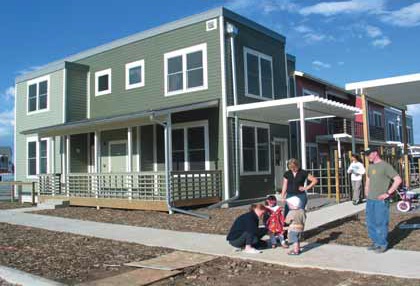|

Wild Sage Cohousing Sets Sustainability Standard
By Wendy Priesnitz
Across North America, a growing number of cohousing neighborhoods are leading the move toward sustainable lifestyles. They are, according to research, driving 30 percent less than the rest of us, paying 50 percent less in utility bills and using 40 percent less water.
But the Wild Sage Cohousing community, built in 2004 in Boulder, Colorado, goes beyond the typical environmental friendliness of similar neighborhoods. The community recently received an EPA energy rating of Five Star Plus – the highest rating given – on all 34 of its attached townhomes.
Cohousing communities are small-scale neighborhoods that provide a balance between personal privacy and living among people who know and care about each other. The concept began in Denmark in the early 1970s. Individual dwelling units enjoy convenient access to shared space, usually including a common house with facilities such as a gourmet kitchen, dining room, a children’s play room, laundry facilities, guest rooms, library, sitting areas, and workshops. Each home is entirely self-sufficient, complete with a kitchen, but residents often prepare meals together in the kitchen of the common house.
Cohousing developments are designed, planned, and managed with a high degree of resident participation. Most major decisions are arrived at through a consensus decision-making process. To make Wild Sage as environmental as possible within their available budget, green building architect and future resident Bryan Bowen and 70 community members met for two years before construction began and agreed on a number of solutions. Among the features chosen by the neighbors were active and passive solar design, airtight housing construction, and a car-free interior courtyard.
“Our houses are so tightly built that air is retained 12 times more efficiently than in a typical U.S. home,” says Bowen of the EPA’s independent air blower door tests. “We designed and placed the homes to stay cool and light in the summer and keep maximum heat in the buildings during the winter.”
Energy conservation features standard in all the Wild Sage townhomes include shared walls and double-paned windows, south facing buildings for strong solar gain, air blown non-toxic insulation, and fittings for photovoltaic panels. In addition, active water conservation measures collect runoff from the roof-tops and channel the rainwater to plants.
As is fairly typical in cohousing, residents’ vehicles are parked at the edge of the property. Homes are also clustered to make as small a building footprint as possible to help preserve the land in its natural state.
Because of the extra planning costs, group facilities, and various environmental innovations, cohousing communities can be expensive. Wild Sage has attempted to accommodate a variety of family sizes and budgets. The cost of units range from just over $100,000 to around $450,000, with about 40 percent of them qualifying under the City of Boulder’s affordable housing program.
Learn More
Wild Sage Cohousing
Wendy Priesnitz is Natural Life Magazine's editor. This article was first published in 2004.
|

